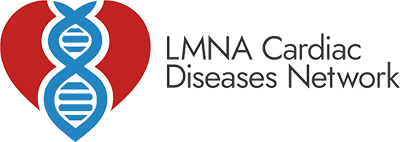Symptoms & Diagnosis
LMNA-related diseases exhibit a notably high penetrance rate, meaning that individuals carrying a mutation in the LMNA gene have a significant likelihood of developing one of the associated conditions. While the exact penetrance rate can vary based on the specific mutation and the disease, it is generally high, often above 90%. This high penetrance rate underscores the importance of genetic counseling and testing for at-risk individuals.
Typically, the onset of LMNA-related diseases varies but often occurs in early adulthood, although symptoms can manifest anytime from adolescence to late in life. Some conditions, like certain forms of muscular dystrophy or progeroid syndromes, may present in childhood, while cardiac manifestations such as Dilated Cardiomyopathy or arrhythmias often become apparent in the 20s to 40s. This variability in age of onset highlights the diverse impact of LMNA mutations and the need for personalized monitoring and management strategies from a young age.
Early Cardiac Symptoms
Early cardiac symptoms are often subtle and can be easily overlooked, but recognizing them is crucial for early intervention.
- Shortness of Breath: Often experienced during physical activities or even at rest in more advanced stages.
- Fatigue: A common early sign, where routine activities may become unexpectedly tiring.
- Palpitations or Heart Flutters: Sensations of a racing, pounding, or irregular heartbeat.
Progression to More Severe Symptoms
As cardiac conditions develop, symptoms typically become more pronounced and severe.
- Chest Pain or Discomfort: Can feel like a squeezing, fullness, or pain in the center of the chest, often spreading to the arms, neck, or back.
- Dizziness or Lightheadedness: May occur due to reduced blood flow to the brain.
- Fainting (Syncope): Caused by a drop in blood pressure or heart rate.
- Swelling in Legs, Ankles, or Abdomen: Often a sign of heart failure.
- Arrhythmias: Severe irregular heartbeats, such as Ventricular Tachycardia (V-Tach) or Ventricular Fibrillation (V-Fib), which require immediate medical attention.
Clinical Assessment
The clinical assessment is the first step in diagnosing cardiac conditions, involving a thorough evaluation of medical history, physical examination, and initial testing.
- Medical History Review: Discussing symptoms, family history of heart disease, and lifestyle factors.
- Physical Examination: Checking for physical signs like heart murmurs, fluid retention, and abnormal heart rhythm.
- Initial Tests: May include blood tests, a chest X-ray, or an Electrocardiogram (ECG) to evaluate heart function.
Genetic Testing
Genetic testing plays a critical role in diagnosing inherited cardiac conditions.
- When to Consider: Especially relevant if there is a family history of heart disease or specific genetic conditions affecting the heart.
- Process: Involves analyzing blood or saliva samples for genetic markers associated with cardiac conditions.
Advanced Imaging and Specialized Tests
Advanced imaging and specialized tests provide detailed insights into the heart’s structure and function, crucial for accurate diagnosis of cardiac conditions.
- Echocardiogram: Ultrasound of the heart to assess its structure and function.
- MRI and CT Scans: Provide detailed images of the heart and surrounding structures.
- Holter Monitoring: Continuous recording of heart rhythm, usually over 24 to 48 hours, to detect arrhythmias.
- Stress Tests: Assess heart function and blood flow during physical exertion.
- Cardiac Catheterization: Invasive test to evaluate the heart’s function and check for blockages in the coronary arteries.
Subscribe To Our Newsletter
Show Your Support
You can make a difference in various ways: by committing as a regular monthly donor, offering a single donation, organizing fundraising events both online and in person, contributing to our special tribute funds, or through your unique fundraising initiatives!
